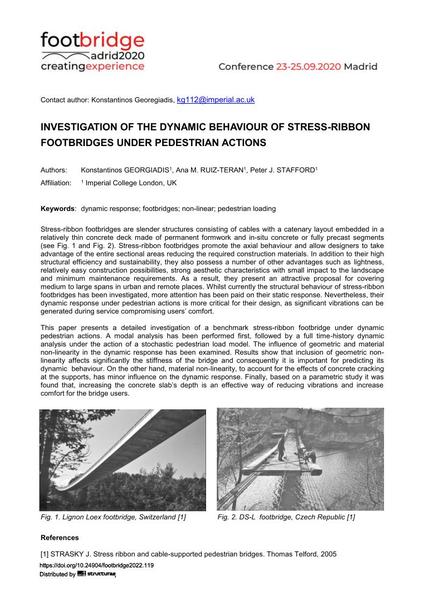Investigation of the Static and the Dynamic Behaviour of Stress-Ribbon Footbridges under Pedestrian Actions

| Auteur(s): |
Konstantinos Georgiadis
(Bridge Engineer in ARUP, PhD, Imperial College London, UK)
Ana M. Ruiz-Teran (Senior Lecturer in Bridge Engineering, Imperial College London, UK) Peter J. Stafford (Reader in Seismology & Earthquake Engineering, Imperial College London, UK) |
|---|---|
| Médium: | papier de conférence |
| Langue(s): | anglais |
| Conférence: | Footbridge 2022: Creating Experience, Madrid, Spain, 07-09 September 2022 |
| Publié dans: | Footbridge Madrid 2022 - Creating Experience |
| DOI: | 10.24904/footbridge2022.119 |
| Abstrait: |
Stress-ribbon footbridges promote the axial behaviour and allow designers to take advantage of the entire sectional areas reducing the required construction materials. In addition to their high structural efficiency and sustainability, they also possess a number of other advantages such as lightness, relatively easy construction possibilities, strong aesthetic characteristics with small impact to the landscape, and minimum maintenance requirements. As a result, they present an attractive proposal for covering medium to large spans in urban and remote places. Whilst currently the structural behaviour of stress-ribbon footbridges has been investigated, more attention has been paid on their static response. Nevertheless, their dynamic response under pedestrian actions might be more critical for their design, as significant vibrations can be generated during service, compromising users’ comfort. This paper presents an investigation of a benchmark stress-ribbon footbridge under static and dynamic pedestrian actions. The influence of geometric non-linearity in the static and the dynamic response was examined. Results show that inclusion of geometric non-linearity affects significantly the stiffness of the bridge and consequently it is important for predicting its behaviour. Finally, based on a parametric study it was found that, increasing the stress-ribbon thickness is an effective way of reducing vibrations and increase comfort for the bridge users. |
| Mots-clé: |
passerelles
|
| License: | Cette oeuvre est soumis au droits d'auteurs. Le(s) détenteur(s) des droits permet(tent) l'utilisation la visualistion et le téléchargement de cette oeuvre. La retransmission ou la publication nécessite la permission des détenteurs des droits. |
0.19 MB Télécharger le texte intégral (fichier PDF)
1.04 MB
- Informations
sur cette fiche - Reference-ID
10667118 - Publié(e) le:
30.05.2022 - Modifié(e) le:
01.06.2022



